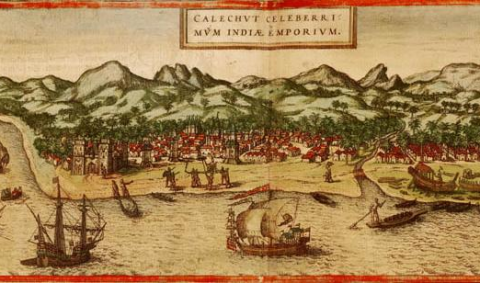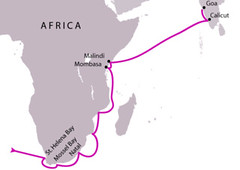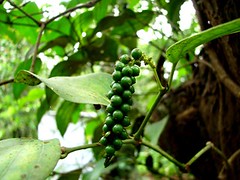 |
| (Calicut as seen in 1572)[1] |
On May 21, 1498, two Tunisian merchants in Calicut, Kerala, were surprised to see a European from Algarve, the southernmost region of mainland Portugal, walk into their house. Their conversation went like this
Tunisian: “What the devil brought you here?”
European: “We came in search of Christians and spices.”
The European was a degredado, a felon or an outcast like a converted Jew. As Europeans renewed world exploration once again in the 15th century, degredados, who were considered expendable, were first released onto the shore in strange lands. If this volunteer came back with his body parts intact, the brave sailors would follow.[2]
This particular degredado had landed from a Portuguese ship and people of Calicut who were used to seeing foreigners knew that he was not Chinese or Malay. Suspecting that he was from the Islamic world they threw a few Arabic words at him and seeing no response, they took him to the house of the Tunisian merchants. Since the man was not harmed, the commander of the Portuguese carrack São Gabriel, Vasco da Gama, set foot on the ground in Kerala and became famous for doing what Christopher Columbus set to do five years back — naming random places, India.
If Vasco da Gama and the Tunisian merchants were to land in present day Calicut, they would be amused to see posters opposing globalization and anti-globalization rhetoric in the words of the rulers. The shocked foreigners would have told Malayalees that Kerala was a globalized land much before the time of Buddha till the 17th century and was wealthy too. Even the degredado, who would have known more history, would have rolled in Kapad beach hearing one of those Achyutanandan sing song speeches.
 Reaching Kerala was not easy; Vasco da Gama’s trip took more than a year since he had to circumnavigate around Africa. After finding a Arab or Gujarati pilot, in Malindi, Kenya, the friendly thrust of the south west monsoons helped them cross the Indian Ocean. Twenty three days later they were in Calicut, one of the largest ports of the time.
Reaching Kerala was not easy; Vasco da Gama’s trip took more than a year since he had to circumnavigate around Africa. After finding a Arab or Gujarati pilot, in Malindi, Kenya, the friendly thrust of the south west monsoons helped them cross the Indian Ocean. Twenty three days later they were in Calicut, one of the largest ports of the time.
There was one reason why remote Malabar coast looked attractive to the residents of Portugal to undertake such perilous voyages. In Malabar, the global epicenter of spice trade, the traders got ginger, cardamom, and cinnamon which were in great demand in Europe. But the treasure they were looking for was pepper; the vines which randomly grows on various trees in my back yard was to Kerala what oil is to Saudi Arabia. Pepper vine grew in many countries, but Malabar brand was considered the best and the monsoons which nourished the pepper vine also bought customers cross the ocean.[3]
In fact, this was not the first time that traders came from distant lands. When Vasco da Gama’s homeland was a barren wilderness of Lusitanian tribesmen, Romans had done it on a much grander scale. 1500 years before the Portuguese trip, Strabo learned on a visit to Egypt that “some 120 ships complete the voyage from the Straits of Hormuz to India”. During Pliny the Elder’s time (AD 23 – August 24, AD 79), Alexandria was the major Roman trading hub. Merchants went up the Nile to Coptos, traveled two hundred miles at night through the desert to Berenice, a port on the Red Sea and set sail from Berenice to Ocelis, on the Arabia’s southern coast or Canes on the Africa’s eastern coast. Then taking advantage of the trade winds, they crossed the Arabian sea in forty days in the mid-September and reached Malabar coast [4] and all this was done at a time when the Garmin nüvi 350 3.5-Inch Portable GPS Navigator was not available for the great sale price of $249.99.
One such journey was recorded by an anonymous Greek speaking sailor in the first century C.E. This document, The Periplus of the Erythrean Sea, describes the journey in detail in freighters which were ocean worthy ships displacing one thousand tonnes. One of the ports mentioned in this document, Muziris, is now thought to be Pattanam near present day Kodungallur. In January, five samples — charcoal, wooden canoe parts and bollards was sent for radiocarbon analysis and the dates showed maritime activity in 500 B.C.E. The wood was identified as Artocarpus hirsutus (Anjily wood) and Tectonagrandis (Teak wood).
 In another port, Nelcynda, located about 500 stadia from Muziris, large ships came carrying thin fabric, linen, corak, crude glass, copper, corn, wine and coins from Rome and went away carrying pepper, pearls, ivory, silk, diamonds and sapphire. According to one hypothesis, Nelcynda is located on Alumthuruthu-Kadapra area on the banks of the river Pampa.
In another port, Nelcynda, located about 500 stadia from Muziris, large ships came carrying thin fabric, linen, corak, crude glass, copper, corn, wine and coins from Rome and went away carrying pepper, pearls, ivory, silk, diamonds and sapphire. According to one hypothesis, Nelcynda is located on Alumthuruthu-Kadapra area on the banks of the river Pampa.
While Indian archaeologists were looking for pieces of wood and charcoal in Kerala, their German counterparts were picking through kitchen scrap on the banks of Lippe River near the present day town of Oberaden. Between 11 and 8 B.C.E this place was the location of a battle between the Roman army and a Germanic people. In the kitchen scrap, archaeologists found olive pits, coriander seeds and black pepper. The Greek poet Antiphanes wrote, “If any one buys pepper and brings it home, They torture him by law like any spy” for only the wealthy were expected to consumer this luxury item.[5]
Excavations of Mesopotamian cities of the third millennium have unearthed specimens of Indian chank, a conch shell found only in the coastal waters of South India and Sri Lanka. Leonard Wooley during his excavations in Ur found pieces of teak — an item usually found in the Malabar coast and this was dated to 600 B.C.E. closer to the Buddha’s time.
The profit margin was 100% for the Romans, but this trade also brought immense wealth to Kerala. Pliny wrote, “India annually swallows up from our state no less than 55 million sesterces.”[6] Silappatikaram mentions, “the beautiful vessels, the masterpieces of the Greeks, stir white foam on the Periyar river..arriving with gold and departing with pepper.” In their trading voyages to West Africa, the Portuguese would trade trinkets for goods and Vasco da Gama was shocked his gifts — honey, hats, scarlet hoods and washbasins — were considered worthless by Calicut natives. The Zamorin instead demanded payments in gold and silver.
This land which was globalized for more than 2000 years is now an economic waste basket, kept on life support by the money sent by Non-Resident Malayalees. Each successive administration has displayed word class efficiency in maintaining the State that way, spending their time on internal party fights. If Pliny’s Roman traders or Vasco da Gama’s sailors were to arrive in Calicut today bearing gold and silver, they would be welcomed by flag waving party cadres shouting anti-globalization slogans and the conversation would go like this:
Distant trader: We come bearing gold and silver in return for your spices.
Party leaders: Watch and enjoy as our cadres use the planks from your ship for building our new party head quarters, you imperialist pig.
Distant trader throws up (due to sea sickness)
References
- Image of Calicut, India from Georg Braun and Franz Hogenber’s atlas Civitates orbis terrarum, 1572.
- A Journal of the First Voyage of Vasco Da Gama, 1497-1499 By Ernest George
- Spice: The History of a Temptation
by Jack Turner
- The History of Egypt by Samuel Sharpe
- The Deipnosophists; Or, Banquet of the Learned by Athenaeus, Charles Duke Yonge
- History of Civilizations of Central Asia By Ahmad Hasan Dani, Vadim Mikhaĭlovich Masson
Technorati Tags: Malabar, Spices, Vasco da Gama, Pliny, Strabo
Nice comparison, Vasco today would have been driven away using an imported ideology, communism…
Nice article, JK – you make an important point. It’s not well understood that globalization is nothing new and that it has been the driving force behind all sorts of innovations. In fact the one lesson one learns from history is that is you shut yourself off from the outside, you’re pretty much doomed.
That’s why I find it hard to understand the “anti-globalization” movement. That term needs to be changed. The final effects of globalization aren’t always just and these things need to be brought to light and protest. But to protest against globalization itself – that’s plain silly!
Nice Article. A random internet search for Raja Raja Chozhan brought me to your blog. This one was anice read. Shall be visiting more pages regularly. Also, thanks for putting up references. I would start reading those as well.